PALACES
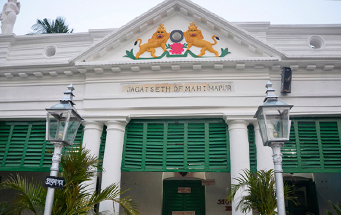
House of Jagat Seth
The Jagat Seth dynasty has been a most illustrious Oswal Jain family of Gailara gotra of India having outstanding achievements and influence in political, religious and business circles.
Jagat Seth meaning the "Banker of the World” was a title conferred on Fateh Chand, a very rich banker in Bengal in the first half of the 18th century. The founder of the house of Jagat Seth was Manick Chand who came to Dhaka from Patna in the early eighteenth century and established a trading firm.
You would find antique furniture, coins, authentic utensils and dresses inside the banking premises. At the back of the house is an underground passage. Also, there is a Lakshmi Narayan Temple which has recently been renovated and an arrangement of tour guides.
You would find antique furniture, coins, authentic utensils and dresses inside the banking premises. At the back of the house is an underground passage. Also, there is a Lakshmi Narayan Temple which has recently been renovated and an arrangement of tour guides.
Kathgola palace
The Katgola Palace with its magnificent structures of the Mandir, Dadabari, Bauri and others set amidst such well-planned sprawling gardens on 155 bighas leave the visitors awe-struck at the sheer dexterity of craftsmanship and quality of buildings. What is, however, unique is its history and that of the family of the Founder. Together with stories of the high personal integrity of Rai Bahadur Lacchmipat Singh Dugar and Dadaguru’s visitation to him, while in a deep meditative trance; stories that have been passed down by word of mouth over
generations, Katgola has a magical appeal.
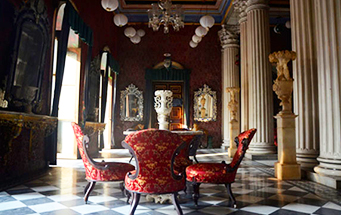
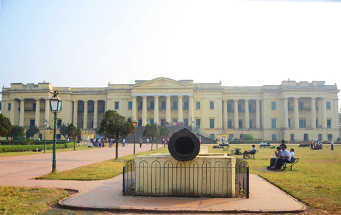
Hazarduari Palace
Spread over a massive area of 41 acres on the eastern banks of the Bhagirathi River, Hazarduari Palace in a European architectural style was built in 1837. The Palace stands tall at the height of 80 feet and has three-stories that comprises of 1000 doors (out of which, 900 doors are real, and the rest are false doors, built to confuse any intruders) 114 rooms and eight galleries.
The palace was built under the supervision of Duncun McLeod for the Nawab Najim Humaun Jah, descendent of Mir Zafar and was used for holding meetings as well as for accommodation of high British officials. It took 8 years (August 1829 – December 1837) to complete the construction work. It is now a museum and displays collection of armory, paintings, vintage cars, Siraj-ud-Daula's prized swords and portraits of the Nawabs. There are certain rare collections in the palace which can be seen only with special permission. The perimeter of the palace also houses the Nizamat Imambara, Wasif Manzil, Bacchawali Tope and the Murshidabad Clock Tower.
The palace was built under the supervision of Duncun McLeod for the Nawab Najim Humaun Jah, descendent of Mir Zafar and was used for holding meetings as well as for accommodation of high British officials. It took 8 years (August 1829 – December 1837) to complete the construction work. It is now a museum and displays collection of armory, paintings, vintage cars, Siraj-ud-Daula's prized swords and portraits of the Nawabs. There are certain rare collections in the palace which can be seen only with special permission. The perimeter of the palace also houses the Nizamat Imambara, Wasif Manzil, Bacchawali Tope and the Murshidabad Clock Tower.
Rajbari
The rich history and heritage of the twin towns of Azimgunj-Jiagunj, in Murshidabad, the last capital of undivided Bengal, Bihar and Orissa is set to stage a second coming, with Neemrana Hotels — which has revolutionized the country’s heritage tourism — taking up Azimgunj Rajbari on the west bank of Bhagirathi as the coveted place to stay to experience the living history of the place.
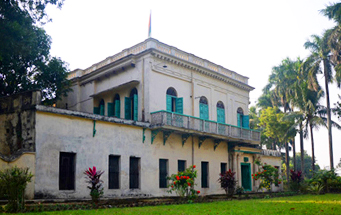

Wasif Manzil
Built by the Nawab of Murshidabad - Nawab Wasif Ali Mirza Khan, this palace is located at the south end of Hazarduari Palace. It is also known as the 'New Palace' because it was built much later. It is smaller than the others but equally beautiful and houses numerous marble statues.
The palace used to have an artificial hill and landscape on its side which got destroyed along with most of the palace in the earthquakes of 1867. The palace was restored, but the hill was never reconstructed again.
The palace used to have an artificial hill and landscape on its side which got destroyed along with most of the palace in the earthquakes of 1867. The palace was restored, but the hill was never reconstructed again.
Bari Kothi
The Bari Kothi was built in the late 1700s. The name of the house, Bari Kothi (literally meaning the Palace of the Elder), was coined in the late 1800s since it was the house of the elder (bari) brother, Rai Bahadur Budh Sing Dudhoria. Bari Kothi is known across Murshidabad as one of the most architecturally significant houses in the region showcasing Greek, Roman and French architecture. The Bari Kothi is spread across three-fourth acres of Land and houses a Sheesh Mahal, Library, Music Room, Durbar Hall, Janana Chowk, Gaddi Ghar, Halwai Khana, Gulabi Chawara amongst other parts of the house.
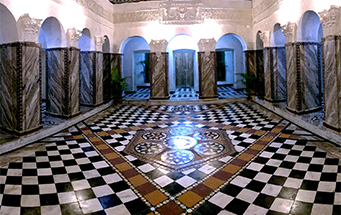
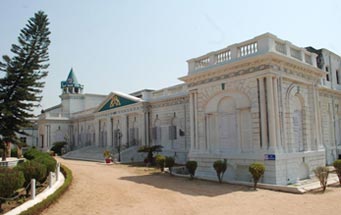
Cossimbazar Palace
Built in the early 1700s, this palace belongs to the Roy family who were then engaged in the flourishing business of Silk export. The palace houses front patio, a Clock tower, Andar mahal, Andar mahal, Sri Sri Radha Gobindo Mandir, Ashutoshnath Shiv Mandir, Lakshmi Mandir, Chandimandap, Majlish Ghar and Gardens.
The huge dimension of the palace required more than 200 guards at different locations to protect from any attack and almost 30 gardeners to look after the lush green gardens and lawns. On your visit to this palace, you will see an exquisite collection for antiques like the British era Chess board; Hokkah sets, Dressing table made of pure “Shegun” wood, etc; which is hard to find in recent days.
The huge dimension of the palace required more than 200 guards at different locations to protect from any attack and almost 30 gardeners to look after the lush green gardens and lawns. On your visit to this palace, you will see an exquisite collection for antiques like the British era Chess board; Hokkah sets, Dressing table made of pure “Shegun” wood, etc; which is hard to find in recent days.

